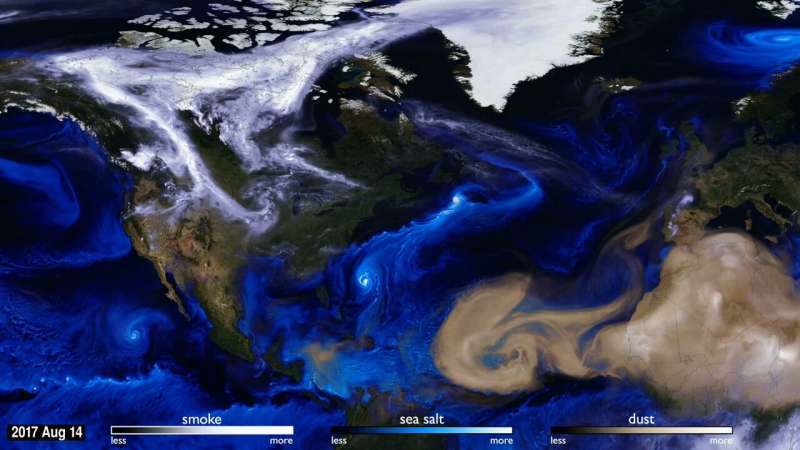This article has been reviewed according to Science X's editorial process and policies. Editors have highlighted the following attributes while ensuring the content's credibility:
fact-checked
trusted source
proofread
How do microbes spread globally? A study clarifies how they travel around the world

A new study published in Current Opinion in Biotechnology compiles the scope of the problem of the global dispersal of harmful microorganisms through the upper layers of the atmosphere.
It confirms that the atmosphere—specifically the free troposphere—acts as a highway for many microbes and emphasizes the mechanisms that facilitate it.
The work combines microbiology and the dynamics of the Earth system, and emphasizes the importance of the intertropical convergence zone in the phenomenon. In this area, above and below the equator, there are strong updrafts of warm air and the winds from the northern and southern hemispheres meet. It is the key area for this massive dispersal of microorganisms through the atmosphere.
When this process occurs, the strong ascending wind that occurs in this strip of the Earth sucks in large masses of aerosolized particles—mainly marine, fire and desert dust. Many microorganisms adhere to them and ascend to the free troposphere (their characteristics and adaptation mechanisms allow it).
Once there, they can travel thousands of kilometers and disperse throughout the world. They can do it thanks to the constant and long-range air currents that converge in the upper layers of upper air and the massive injection that occurs in the intertropical zone.
A cross-sectional study
This study is part of the AEROSMIC project and has a strong cross-sectional component. It connects the study of microscopic life forms with that of the global dynamics of planet Earth. It unites disciplines such as microbiology, physics and meteorology to deepen the knowledge of the long-range dispersal mechanisms of microorganisms.
To carry it out, researchers spent seven years collecting samples of microorganisms present in the upper layers of the atmosphere. They analyzed the DNA of these microorganisms along with data provided by NASA satellites regarding the movement of large air masses and aerosols. All the data obtained were processed by biocomputation. This methodology allowed them to extract patterns and reach the conclusions presented in the work.
The research underlines that this natural phenomenon is exacerbated by climate change and by other consequences of human intervention, such as deforestation and the drying up of large wetlands. The increase in arid areas and deserts leads to a greater inhalation of dust, and therefore of microorganisms, including some pathogens. Likewise, climate change is altering the dynamics of global air currents; it can cause them to go where they previously did not, thus changing the dynamics of ecosystems on a global scale.
In addition to clarifying the mechanisms of atmospheric dispersion, the study provides insight into the types of microorganisms that manage to travel in this way. They must be able to stick and lift, as well as withstand the extreme conditions of the upper atmosphere. Some have developed adaptive strategies that allow it. DNA analysis of these microscopic life forms has concluded that most of them are innocuous, and some are even beneficial for the natural dynamics of ecosystems.
Others, however, are harmful. Among the most detected potentially harmful microorganisms are those that harm plants. In second place are those that affect fish, amphibians and other animals. After that come those that can directly make humans sick. Researchers have detected a significant presence of allergens, as well as antibiotic-resistant microbes that can travel long distances, among others.
For all these reasons, the phenomenon has important implications for global health and it is important to address it from a global and systemic perspective to minimize the spread of diseases and preserve the health of ecosystems.
The main author of the article, the researcher from Blanes Centre for Advanced Studies (CEAB-CSIC) Emilio O. Casamayor, explains that the work includes scientific arguments so that managers act from a global vision: "Situations that are occurring in remote places have effects in any corner of the planet. Especially these areas in the south of the Sahara, which are judged to be of little floristic and faunal interest, should be taken care of for the common good, because they are areas of high aerosol emission that have effects on different ecosystems that are far away".
Casamayor highlights that often what is being dispersed are potentially harmful elements "from countries where there are fewer legal restrictions for the massive use of harmful products or where they dump. These products are aerosolized in global aspiration zones and deposited thousands of kilometers away in places where protection regulations may be very strict, but do not contemplate the atmospheric inputs of remote pollutants."
These areas of the intertropical convergence zone that would benefit from special care are northern Brazil, the Caribbean and the Amazon, the sub-Saharan zone, northern Madagascar, the Gobi desert (between China and Mongolia) and the area north of Australia, among others.
More information: Emilio O Casamayor et al, Understanding atmospheric intercontinental dispersal of harmful microorganisms, Current Opinion in Biotechnology (2023). DOI: 10.1016/j.copbio.2023.102945
Provided by Spanish National Research Council


















